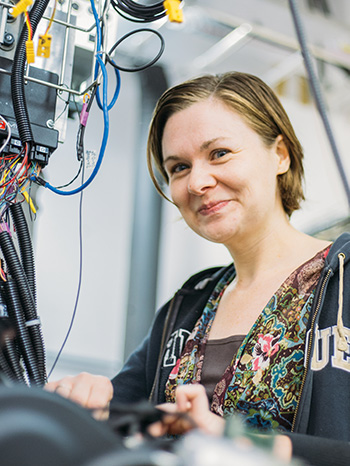O
ptimizing fuel performance and minimizing emissions has been the ambition of every engineer who designed a combustion engine since George Brayton developed his “ready motor” in 1872. Illinois Tech Assistant Professor of Mechanical, Materials, and Aerospace Engineering Carrie Hall is currently at the cutting edge of that search for new ways to make diesel engines cleaner and more efficient using dual-fuel technology.

Photo: Scott Benbrook
Hall, the recipient of a $500,000 Faculty Early Career Development (CAREER) Award from the National Science Foundation, is applying innovations from studies of single-cylinder engines that use dual-fuel technology to multi-cylinder engines like those found in commercial trucks. Dual-fuel models like the Volvo V90 Bi-Fuel use a blend of two fuels, such as natural gas and gasoline. Each fuel is optimally efficient under different conditions, and using both allows for a more efficient engine overall. The goal is to develop automotive engines that can use an ideal blend of fuels that run more cleanly and provide the most efficient power output for the load demands on the engine.
“In passenger cars it’s simpler to just go to electric or hybrid vehicles,” says Hall. “But for larger Class A trucks, we can’t have an electric option. They’re going to have to burn diesel fuel or something like it for the foreseeable future. These technologies could make them potentially more efficient.”
Hall’s current research is focused on understanding the fundamental dynamics of how a multi-cylinder, dual-fuel engine operates under various conditions. The next stage, she says, is understanding how to control such a complex, nonlinear system. “That becomes a very challenging mathematical problem, so lessons that we learn certainly have applications that we can take into other things,” she says. “We’re dealing with something that’s producing power from two sources, which is the same kind of thing that you’re doing on a hybrid vehicle, so a lot of other applications will have similar kinds of constraints and issues.”
Hall became interested in engine technology because she wanted to tackle what she considers to be one of today’s biggest problems: how to efficiently produce energy with minimal environmental ramifications. She was drawn to automotive engineering because of the challenges involved in producing energy in a moving object. “You can produce energy in a stationary thing that’s just sitting there,” she says, “or you can produce it in something that’s moving around, and something that’s moving around is a lot more fun.”